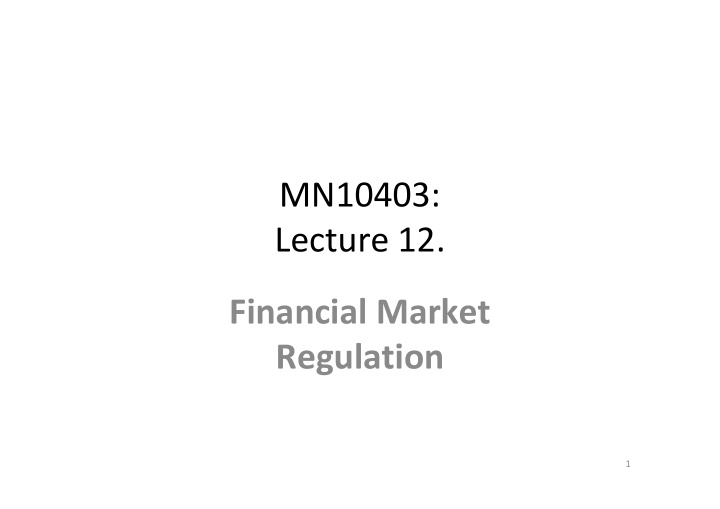



MN10403: Lecture 12. Financial Market Regulation 1
Lecture Structure � Reasons for and against regulation � Reasons for and against self-regulation � Developments in regulation in the 1980s and 1990s � Effects of globalisation and derivative markets � International attempts to deal with regulatory problems. 2
Market Failure � Asymmetric Information � Moral Hazard Problems � Banking System and Markets rely on confidence. 3
Reasons for regulation � Degree of competition in a market � Protection of consumers of financial products � Encouraging small investors � Capital adequacy of financial institutions � Ability of small firms to obtain finance � Preservation of market and practitioner reputation 4
Collapse of Banking System � Contagion � Consumer Protection � Bank Liabilities form a means of payment => important for economic growth 5
Examples of Financial Market Losers � Lloyds of London names � UK Private Pensions � Split Capital Investment Trusts � These cases demonstrate mixed attitudes towards losers 6
FSA � Set up by the FSMA 2000. � 4 Major Statutory objectives: � market confidence � Consumer Awareness � Consumer Protection � Fighting Financial Crime (Market Abuse, insider trading, market cleanliness: eg Biffa). 7
FSA tests of Market Cleanliness Share Price Time Market Inefficiency => possibility of Insider Trading 8
Theory of Regulation � Market Failure (asymmetric info/moral hazard � But: Regulation itself may create moral hazard. � Agency Capture. � Compliance Costs � => increases cost of entry � => regulation inhibits competition? � => reduces financial mkt’s efficiency to allocate scarce resources. 9
Deregulation? � Regulation keeps out new entrants � Regulation prevents M and A. 10
Form of Regulation. � Who should carry out the regulation? � Government (statutory regulation)? � Or the financial industry itself (Self-regulation) � Argument for self-regulation: � Industry has a commercial incentive to protect its reputation � Practitioners understand the needs of the industry � => statutory regulators impose excessive safety standards => higher cost of regulation. 11
Self-regulation. � Lighter than statutory regulation � But awkward half-way house? � Free-riders may not join industry regulation scheme � => Must be supported by some govt reg � Self-regulation and moral hazard/ exploitation of risk (see page 365 – 367) 12
Financial Regulation in UK � 2 major reorganisations in a decade � 1986-1987: Big Bang in Equity markets � Rapid internationalisation of financial markets � Financial services act 1986 � Banking Act 1987 � 1998 reforms. 13
Conclusion � Financial Services Industry heavily regulated � Loss of Confidence: � + Mkt failure => Regulation � Statutory regulation Versus Self-regulation debate. � Regulation hindered by single EU financial mkt, globalisation and complex derivatives markets. 14
Summary of Course: � Introduction to the Financial markets, the key players and institutions. � Purpose of FM: efficient transfer of funds from lenders to borrowers => econ growth. � But: inefficiencies in FM due to moral hazard and asymmetric info. � FM consist of banking sector, money markets, bond markets, equity markets (and derivative markets). � Bond pricing and equity pricing: Fundamental value, market value, EMH => � DCF models: Supply and demand: price behaviour also affected by psychology: eg bubbles. � Market failure => need for regulation � FSA => CBA, market abuse, mkt cleanliness, insider trading, fraud. � Key question: self-regulation or statutory regulation? 15
Recommend
More recommend